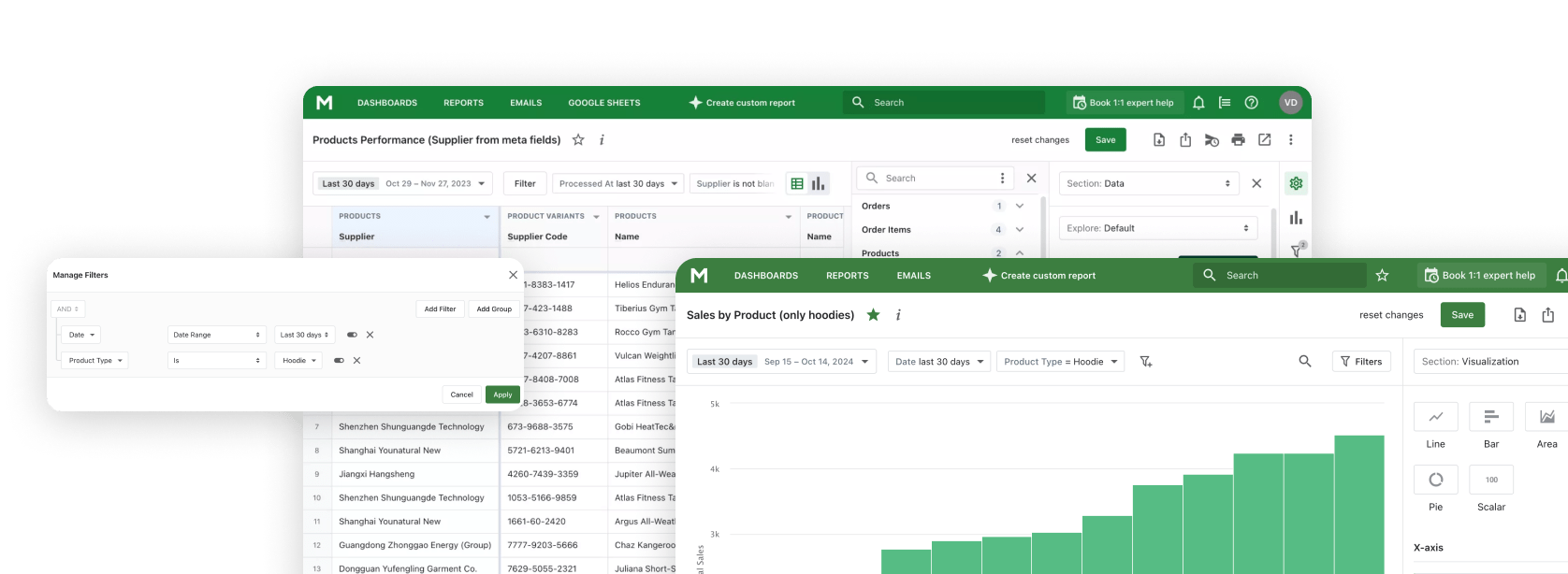Introduction
We invite everyone interested to find out whether their investments in Shopify store advertising have paid off. Today, you will receive an answer to this question and a tool to help you quickly calculate it.
Attracting customers guarantees the further development and success of the Shopify store. Therefore, marketing activities are very important. The main thing is to monitor whether they are effective enough. The ROI indicator shows how much your investments in marketing activities paid off.
We decided to raise this critical question in this article. Money should work for you. Therefore, today, we will understand Marketing ROI for Shopify stores. We will also help understand what affects the ROI result and how it can be improved. Of course, we will consider existing examples and possible tools for calculating it.
We also created a Google Sheets template to calculate ROI for you. It's free and will help you measure the results of your marketing campaigns without any extra hassle.
Understanding Shopify ROI
ROI definition and formula
ROI stands for return on investments. This is the metric that measures the effectiveness of your marketing efforts compared to costs. Simply put: how much sales or revenue you get for your marketing investment.
Since this article focuses only on Shopify stores, we are interested in exactly how many new customers your marketing efforts have brought. And also how much they have bought your product.
Another important clarification: we will only consider marketing ROI. Very often, ROI is used in a broader sense. We will evaluate how effectively your investments in marketing your store worked.

(Net profit from marketing - Cost of marketing) - this part of the formula is the net profit you received from advertising. This does not include your marketing costs. You can also make the formula even more accurate and consider the cost of goods sold. The formula will then look like this:

In this case, you get a completely net profit from a marketing campaign.
Marketing Costs: This category includes all expenses related to marketing. It encompasses a variety of items such as:
- The cost of advertising campaigns
- Fees for each targeted action
- Advertising fees
- Payment for an SMM manager
- Payment for marketing professionals
- Content creation costs
- Purchasing additional applications for content optimization
- SEO expenses
- Additional inventory for Instagram Reels
Everything you consider marketing expenses is added here. In this article, we will describe and use the first version of the formula. It is more canonical. But no one forbids you to add the cost of goods sold. This will help to see the result even more accurately.
How does Shopify ROI work?
The value that you will get as a result of the calculation will answer two questions:
- Did your investment pay off?
- What percentage of your advertising budget is your profit?
We will provide two examples so that you understand how ROI works and compare their results.
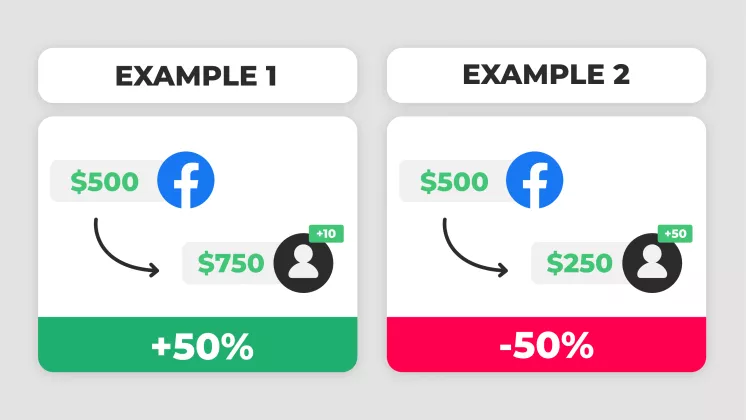
You spent $500 on a Facebook marketing campaign.
Thanks to this, 10 new
customers have bought $750 worth of goods from you.
Calculation: (750 - 500) / 500 = 50%
You spent $500 on a Facebook marketing campaign.
Thanks to this, 50 new
customers have bought $250 worth of goods from you.
Calculation: (250 - 500) / 500 = -50%
The difference in results can be seen immediately. Let's analyze them:
- The ROI value will be negative if your investment has not yet paid off.
- If your investment pays off, the result will show what percentage of the invested amount will be profit. Since you have already covered the losses, the net profit is calculated. You can dispose of it as you see fit. Keep in mind that the cost of your goods will still need to be deducted from this profit.
- If your investment did not pay off, then the result will show what percentage of the investment you still need to cover.
These examples are very primitive, but in addition to the given conclusions, you can also understand a lot of other things. You will see which marketing campaign was successful and which was not. You can decide which promotion channel to invest money in next. If you've recently changed your strategy, see if your audience likes them.
Mistakes in understanding ROI
Also, we would like to caution you against the wrong conclusions you can draw using ROI. Understanding what we will write below will make it easier for you to work with this indicator.
- ROI does not show the result in the moment. In order for your investment to pay off and for you to get a satisfactory result, you need to wait several months for the marketing campaign to work.
- ROI is not a static value. It changes over time. Be prepared for the fact that after some time it may increase or decrease.
- ROI depends on many factors. You will need to consider each of them to improve the result.
Key Factors Affecting Shopify ROI
As we have already mentioned, many factors affect the ROI result. Conventionally, they can be divided into several groups:
| Group | Details |
|---|---|
| Your Expenses |
|
| The Behavior of Your Customers |
|
| Factors of Indirect Influence |
|
Some of these factors have a significant impact on the result. For example, the amount of your marketing spend can greatly influence ROI. Your income also depends on customer behavior, and while factors of indirect influence are harder to quantify, they still play a role in the overall result.
Strategies to increase Shopify ROI
You can influence the ROI result. If you are not satisfied with the result, try changing the approach. We offer several strategies. They will help you check some actions and tell you how to improve the results.
Strategies
- Target the right audience: Use data analytics to refine your audience targeting.
- Optimize ad spend: Test creatives, keywords, and audience segments to reduce CAC and increase ROI.
- Use retargeting: Use retargeting ads to re-engage visitors who didn't convert on their first visit.
- Focus on channels with high ROI: There's no need to waste time and money on channels that won't attract new customers.
- Improve customer experience: Ease of use of the site and high-quality customer service can increase the ROI.
- Use upsells and cross-sells: Increase your AOV with upsells, cross-sells, and bundled offers.
- Implement Loyalty Programs: Encourage repeat purchases and increase LTV with rewards programs.

Tools and Resources for ROI Optimization
There are several applications for Shopify stores that help calculate ROI. However, no application will be able to calculate it completely by itself. You pay not only for advertising campaigns but also for the work of specialists, applications, and content writing.
No app can know your expenses completely. It is because of this that ROI will have to be calculated manually. The applications described below will show you the Net profit from marketing and the partial Cost of marketing. You will only need to add the other cost of marketing and do the math.
Google Analytics
This program allows you to track traffic sources, conversions, and the effectiveness of marketing channels. To maximize the benefits of Google Analytics, it should be integrated with all your channels and platforms. Then, all information about promotion costs will be collected automatically and in one place.
Google Ads
Google Ads is usually integrated with Google Analytics. Google Ads provides access to advertising costs and campaign performance.
Facebook Ads / LinkedIn Ads / TikTok Ads / Instagram Ads
Each of these applications analyzes the advertising campaign only within the respective social network. They reflect costs and the effectiveness of these costs. You need to integrate with Google Analytics to gather all the information together. This happens with the help of UTM tags.
Analytics in Shopify
In the administration part of your store, there is a section called Analytics. Conversion by first interaction report and Sales by attributed to marketing report allow you to get comprehensive information. You may calculate the ROI of your marketing efforts manually.
You can also give Google Analytics access to information about your ad revenue. This allows you to compare costs with income and compare the effectiveness of each information channel.
Omnisend or Klaviyo
These applications can independently calculate the ROI for each marketing campaign for which they are responsible - email, SMS, push-message. In addition, they can be integrated with Google Analytics.
Mipler Template to calculate Shopify ROI
To calculate ROI using the Mipler Template, we need to:
- Make copy of Mipler ROI template for Shopify stores:
- Open Shopify admin panel of your store.
- Go to Analytics > Reports menu.
- Navigate to “Sales over time report”.
- If necessary, set the desired reporting period.
- Add the following columns in this specific order:
- UTM campaign medium
- UTM campaign name
- UTM campaign source
- Export this report.
- Open the report you downloaded and paste it on the first sheet of copy of our template.



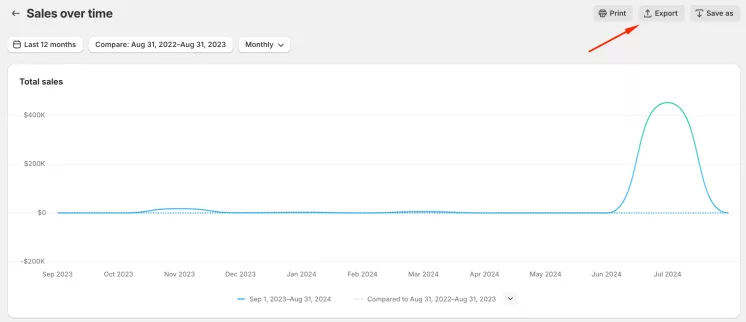

We have completed the preparation. Now we can see the calculations. Go to the second tab, “ROI by utm_campaign”. In the “spent_on_campaign” column, enter the amount spent on the advertising campaign:
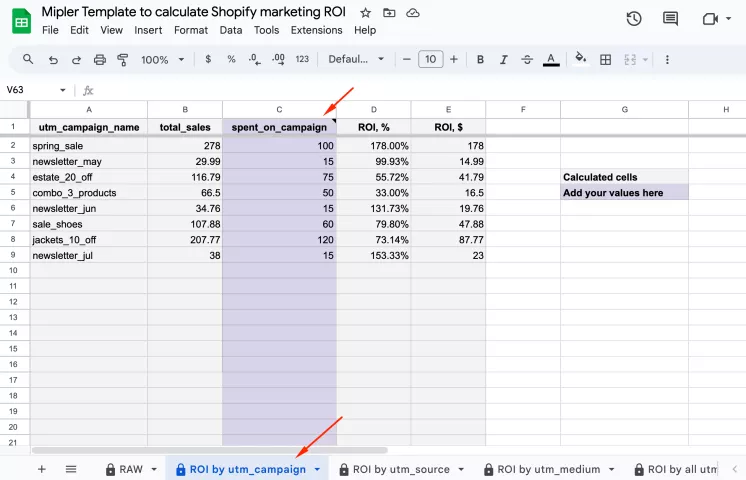
Once this is done, you will see other values, such as ROI %, and ROI in dollars ($). Additionally, our template includes extra reports and one dashboard, such as:
- ROI by source
- ROI by medium
- ROI by all utm_parameters
- Summary (dashboard)
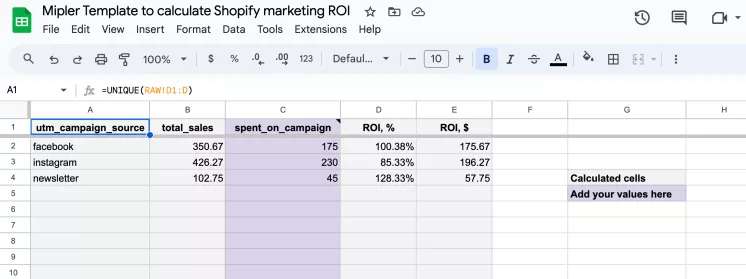
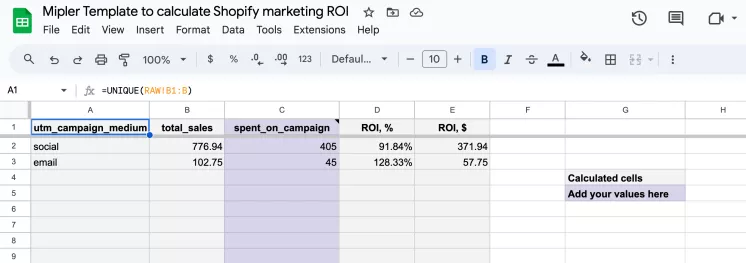
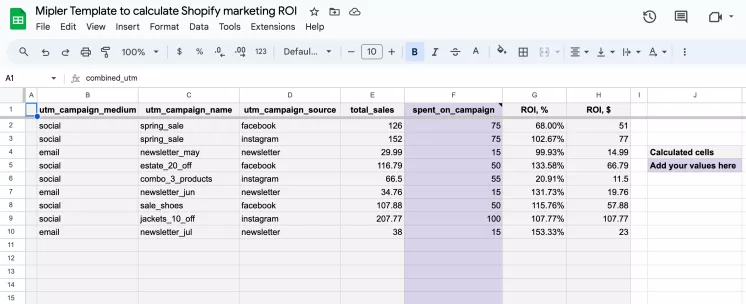

On the last “Summary” tab, you are able to find general statistics across all your campaigns. Common overview:

Examples of the widgets:
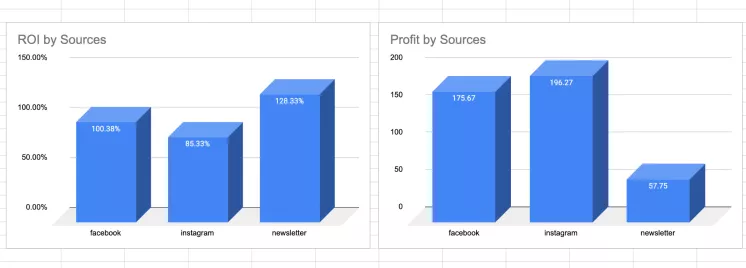
Case Studies and Real-World Examples
In order to improve ROI indicators, a set of measures is required. Let's consider possible strategies using examples of Shopify stores.
MVMT
MVMT is a direct-to-consumer brand of watches, sunglasses and accessories. The main actions taken:
- Influencer Marketing: MVMT invested heavily in partnerships with Instagram and YouTube influencers, reaching their target audience.
- Optimized Paid Advertising: They used Facebook ads and Google Ads to target lookalike audiences and then retargeted visitors who abandoned their shopping carts.
- Email Marketing with Klaviyo: They personalized their outreach and segmented consumers effectively.
- Improved Customer Experience: The store focuses on providing a flawless user experience.
As a result of these actions, they were able to increase ROI and reduce the cost of customer acquisition. They focused on personalizing communication with the audience through influencers and e-mail.
Beardbrand
Beardbrand is a company that manufactures personal care products.
- Audience Trust: First of all, they focused on very high-quality content on YouTube and blog posts. They confirmed their authority and increased trust in the brand.
- Email Marketing: Using Omnisend, they set up automated email sequences, including a series of welcome messages, product recommendations, and educational content.
- Paid Search and Social Ads: Beardbrand used targeted Google and Facebook ads to attract customers effectively.
This store chose the path of independent building of trust in the brand. And in this way they can control the situation. They increased organic traffic and reduced reliance on paid advertising while lowering CAC. And they were also able to increase the percentage of repeat purchases. This way they were able to increase their ROI.
Conclusion
It's hard to imagine the development of a modern business without promotion and constant analysis of the Shopify Sales Report. Marketing is very often the driving force behind success. Each business is unique, so it should choose the development strategies that will suit it. And ROI will help to understand whether these strategies were successful.
Unfortunately, it is impossible to automatically calculate this indicator. However, by using a set of programs, you can facilitate this process. And our template will be able to independently calculate the return on investment, if you enter the necessary data. Download it and use the data you need.

